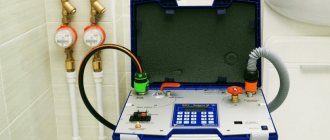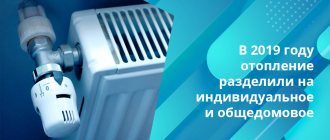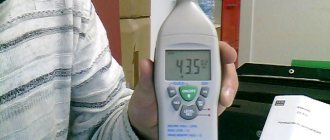What is ODPU
ODPU stands for common house metering devices. The concept is no longer a novelty, since back on November 21, 2009, Federal Law No. 261 “On energy saving and increasing energy efficiency and on introducing amendments to certain legislative acts of the Russian Federation” was adopted.
It states that owners of premises in apartment buildings are required to install meters before July 1, 2012. But this process is slow and, as we can see, has not been completed to this day. Therefore, in April 2013, by Government Resolution No. 344, it was decided to introduce increasing coefficients to the utility consumption standards.
What is their need?
These devices are installed and used to account for utility costs for residents of the entire apartment building, and not for a separate riser or entrance. Simply put, they display how many resources the residents of the house spent in a certain period of time (usually a month). It turns out that ODPU is the expense for utilities at home.
The right solution would be to install not only meters that measure the costs of the entire house, but also apartment ones, because thanks to their joint work we get the opportunity to correctly determine the consumption of certain services, we can calculate leaks or calculation errors, analyze the condition of devices and, of course, we can save (more on this below).
Also, the installation of ODPU, according to the content of Federal Law No. 261 , is a measure necessary to save the resources provided: water, gas and electricity.
Is it possible not to install devices?
Yes, this is possible, but only if you do not have the technical capabilities to equip your home with individual and communal metering devices. You can find the criteria for these possibilities in Order No. 627 of the Ministry of Economic Development dated December 29, 2011. The same document provides a form for a sequential analysis of residential premises and the procedure for filling out this act.
If your house has technical capabilities, then, according to Federal Law No. 261, communal meters must be installed in all apartment buildings. If they are not there, pay extra for utilities.
Who is financially responsible?
The installation of communal metering devices is fully paid for by homeowners.
As part of the assistance, the state allows the use of installments for 5 years , during which time the amount spent on the installation of equipment is indicated in utility bills. If it is possible to pay in one payment, then the payment is made before or after installation.
Example: If the area of the premises is 120 sq.m., the area of the house is 10,000 sq.m., the total property (basement, playground) is 2,000 sq.m., the owner pays: 120 / 10,000* 2,000 = 24 sq.m. m.
Criteria for influencing the cost of common house metering devices
To calculate the installation of ODPU, it is necessary to measure the area of the apartment of each resident and multiply by the cost of the meter per 1 sq.m.
Calculation example: 56.8 sq. m. * 91.7 rub. = 5,208.6 rub.
In the case of a general decision to install, using installments, it is necessary to divide the calculated cost by 60 (the number of monthly payments for five years).
Calculation example: RUB 5,208.6 : 60 = 86.8 rub. monthly fee.
Additionally, the Housing Code prescribes specific criteria on which the establishment of the DPPU will depend.
These include: payment for the cost of the device, preliminary consultation, drafting a project, payment for installation, setting up and launching the device, five-year maintenance.
Types of common house metering devices
All ODPU are divided into four types:
- To account for thermal energy . There are tachometer, ultrasonic, electromagnetic and vortex instruments. Another advantage of the installation is that housing and communal services and residents have the opportunity to regulate the temperature of the coolant.
- For electricity, individual and multi-tariff communal metering devices. A multi-tariff meter really helps to save money, because at night the tariff is set, which is much cheaper than the daytime one.
- ODPU for calculating hot and cold water. Instead of approximately calculating the resources spent, it helps to determine the amount of resources actually spent based on the number of people registered in the house.
- ODPU for metering gas consumption.
At what objects is a meter needed, and where is it not necessary to install it?
The law determines that all owners of buildings, houses, and apartments are required to equip their buildings with communal heating meters by 2011. What is regulated by Article 13, Section 4 of Federal Law No. 261.
And section 3 obliges all government organizations to equip them with thermal appliances. However, Section 1 of Article 13 indicates facilities where the installation of meters is not required.
These are emergency or dilapidated buildings, structures that are subject to demolition. There is no need to install heat meters on houses with a maximum consumption of thermal energy not exceeding two tenths of a gigacalorie per hour.
Tariffs and display of MTPL on the receipt
Before we talk about tariffs, we’ll tell you in more detail what the ODPU line is in the receipt that will appear after installing the devices.
So, this line is called “Compensation for the costs of installing ODPU”. This will be indicated monthly during the installation installment payment period (period of approximately 5 years) and is subject to change. Don't be alarmed if you discover this phenomenon.
There are two reasons for this:
- the payment amount is subject to changes by the amount of interest determined in the amount of the refinancing rate of the Central Bank of the Russian Federation. Roughly speaking, if the amount was not paid in full, then the size of the balance will increase taking into account the interest rate charged on it;
- maintenance or replacement of a common house meter. During operation (and in a number of houses the meters work for quite a long time), the need arises for routine maintenance and repair work, which, according to Law 261, is also reimbursed by the owners of the premises.
Now about the tariff. It is likely that when you receive a new receipt, you will also ask yourself the question: “What is the TDPU of electricity?” Any apartment building has common areas, such as entrances. Such rooms also have electricity and, sometimes, even water. Payment for these services applies to all residents of the house.
If there is an ODPU, the calculation is quite simple:
C (general). = [P – P(ind.)] x T
Where:
- C (general) - payment for received utilities in public areas;
- P – ODPU readings;
- P (ind.) – readings of an individual (apartment) meter;
- T is the current tariff for this service.
You can also find the specified calculation procedure in the Rules for the Provision of Utilities No. 307. If there is no common household appliance, then the payment for utilities in common areas is calculated according to the standards.
Attention . From 2021, the amount received is multiplied by an increasing factor of 1.6. Those. the amount payable increases by 60%. It is obvious that there is a benefit from installing an ODPU, and it is significant.
How to correctly read the symbols on a utility bill, watch the video at the end of the article.
Sequence of actions during installation of ODPU
Installation of heating equipment is carried out by enterprises with special permits.
Steps for installing meters:
- positive installation decision by all homeowners;
- selection of an organization specialized in installation;
- fixing the installation location and additional control;
- obtaining technical certificates for installing the device;
- approval of design and estimate documentation;
- preparation of papers and their coordination with the supplier;
- purchase of equipment;
- installation of a metering device;
- additional work on launching and configuring equipment.
In accordance with clause 13 of Article 13 of the Federal Law “On Energy Saving”, all costs for installing ODPU are paid by the owners of the resource supplying organization.
Requirements for water supply systems
Under operating conditions, meters often fail; in order to minimize the number of replacements, it is necessary to monitor their serviceability.
Requirements for pipes:
- high-quality and clean water;
- stable pressure;
- without external or internal damage;
- no air bubbles.
To increase reliability parameters, it is necessary to use backup equipment.
Procedure for replacing and checking meters
Since the ODPU belongs to all residents of the house, the responsibility for its control, repair and possible replacement also applies to them. But, of course, it is not the residents themselves who fulfill these requirements, but the management company, which appoints qualified specialists to carry out the work. And as a result, the management company bears responsibility for the technical condition of the devices.
Each meter has its own verification interval - the period during which the readings of the meter are considered reliable based on the information obtained during the previous verification. The calibration interval is determined by the manufacturer of the metering device based on a combination of factors that may affect its operation: design, principle of operation, operating conditions.
The manufacturer indicates the verification interval for the metering device in its documentation. For example, domestic manufacturers of water meters indicate in the device passport the calibration interval of 4–6 years. Imported meters last longer – up to 15 years.
It is worth noting that the company hired to service the meters must have the appropriate certificate. After all, in the future she often checks the condition of the meters and replaces them if it is impossible to repair the old one on an ongoing basis.
During an external inspection of the device, the specialist checks:
- device documentation;
- the condition of its paintwork;
- clarity of inscriptions and symbols on the case, numbers and marks on the dial and rollers of the reading device;
- the presence of stains, cracks and chips that affect readings.
After each event, a report must be drawn up that describes the current state of the device and further actions if, for example, the need for replacement has been determined. The act is signed by the employee who conducted the inspection and a representative of the management company.
How much does it cost and who pays
The issue of the cost of equipment and related services becomes paramount. Since, according to the law, residents of an apartment building must pay for equipment, design, commissioning and commissioning.
As a result, the common building meter becomes the collective property of the residents. The cost of heat meters depends on the manufacturer and type of equipment:
- Inexpensive devices with a short service life of 2 to 4 years, costing from 6 to 10 thousand rubles. These are meters that use a rotor as an actuator;
- More reliable electronic devices cost from 15 to 100 thousand rubles. The service life of such devices is 10-15 years.
But this is not the main price you need to pay for installation.
Total costs consist of the following expense items:
- Design work. This includes the development and approval of the project. The estimated cost is 50 thousand rubles;
- Heat meter. Usually they choose reliable devices in the middle price category of about 60 thousand rubles. With a service life of at least 10 years;
- Additional equipment, flow meters and sensors. The price of the devices is 40 thousand rubles;
- Installation of equipment and auxiliary materials. Repair of worn-out networks is taken into account. The cost of the work is 90 thousand rubles;
- Equipment setup and commissioning costs 10 thousand rubles.
The cost of installation and commissioning of a thermal energy meter ranges from 180 to 300 thousand rubles. This is the estimated price for the work. It depends on the organization that will perform installation, commissioning and commissioning.
The management company does not perform this work; they require special permission.
Is it possible not to pay for installing a meter?
In some cases, a heat meter can be installed free of charge. This option is possible when residents do not have the funds to pay for a heat meter.
The management company or homeowners association enters into an energy service contract. According to it, the energy service company purchases and installs equipment at its own expense.
After installing the structure and putting it into operation, the heat meter is leased. Payment for equipment is made at the rate of 80% of the savings achieved. The energy service company takes it, and 20% remains the property of the residents.
For example, a house paid 400 thousand rubles for heat before installing a meter. After installation, the payment decreased to 350 thousand. Saving 50 thousand rubles. The energy supply company takes 40 thousand rubles.
According to the leasing agreement, she receives 300 thousand. Thus, after (300/40=7.5) 7.5 months, the equipment will be transferred to the residents of the house. After the heat meter is handed over to the residents, all savings are distributed among the apartment owners.
Read what the temperature in the apartment should be during the heating season and how to request a recalculation for cold radiators.
Procedure for residents and management companies when installing meters
Home owners should start with a general meeting. It is usually carried out by the management company. This is where the decision to install equipment is made.
Select the type of device and approve the preliminary budget. After the meeting, a contractor is selected and an agreement is concluded with it to perform the work.
Together with the management organization, residents monitor the progress of work. If necessary, adjustments are made. Participate in testing. They are present when the facility is handed over to the heat supply company, which seals the devices and draws up a commissioning report.
Only after the heat supply company has accepted the work, the meter readings are the basis for payment for heat.
At the same time, you do not need to rely on the management company. She can organize a general meeting of residents, explain the need to install a meter, and draw up the relevant documents. And in some cases, help select a contractor.
But choosing a contractor, purchasing equipment, drawing up contracts for installation and commissioning work fall on the shoulders of the residents of an apartment building.
Device functions
The authorities require the installation of common resource meters in apartment buildings, since such devices make it possible to identify the real consumption of resources. For example, if only one citizen is registered in an apartment, then tariffs are calculated on him alone, but in fact a whole family lives in the apartment, which significantly increases the real expense.
The benefit of installing an ODPU (as described above) is also determined for residents who have individual meters for metering consumed resources in their apartments. Experts believe that individual meters are generally ineffective without installing common ones. This is justified by the fact that the presence of both individual and general metering devices helps:
- detect resource leaks in a timely manner;
- improve the payment formula;
- correctly analyze pressure, temperature and other parameters of supplied resources;
- correctly determine who exactly bears the losses in case of system violations.
In addition to this benefit for the management company, residents with individual meters in their apartments also have an advantage in installing ODPU. The fact is that their presence does not mean that the receipt will not contain a line of expenses for general house needs, which represents the expenditure of resources on servicing the elevator, playgrounds, basements and staircases. Ideally, this item should not exceed 2% of the amount of individual consumption, but in fact, all resources consumed by the entrance in excess of meter readings are taken into account here, including due to any leaks in the system.
It helps to normalize this column and correctly determine the location of the leak by installing the ODPU. What is this ability? It’s just that all leaks on the main line will no longer be included in the payment. The device records only those resources that actually entered the house. Of course, leaks may already be inside the house itself, and there are still enough reasons to raise the tariff, but the presence of such a device allows you to significantly reduce costs and is the first step towards savings.
Purchase and installation of a common house heat meter
Before the general meeting where a decision on the type of meter will be made, it is recommended to contact an organization that installs and maintains heat metering devices.
The contractor's engineers, on the instructions of the residents, will carry out the following work:
- Audit of the home heating system;
- Based on the audit data, they will recommend the type of device that will meet all the necessary requirements. It should be taken into account that many meters have blocks for remote data transfer. And the service life must be at least 10 years;
- They will develop design documentation, install and commission the meter;
- After the end of the warranty period, maintenance of heat meters will be carried out.
When applying, you should find out whether the company has permission to perform this type of work.
The nuances of paying for testimony
Some are still convinced that all remaining residents are required to pay for a persistent defaulter, since the difference between the accrued readings for individual apartments and the entire building is shared by everyone. In fact, its consumption indicators are taken into account separately according to the tariff or readings of individual meters of a particular apartment and when forming payment for the general needs of the house, it is deducted from the amount.
Commercial organizations located in a residential building also pay their expenses separately from the owners.








